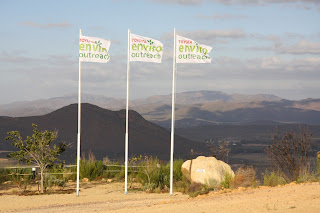 |
| Welcome to the Toyota Enviro Outreach |
 |
| Klipbokkop hosts the Toyota Enviro Outreach this year. |
Prof Michele van der Bank from the University of Johannesburg is once again leading the research team of the 2012 Toyota Enviro Outreach. She explains the importance of the this years focus on invasive species and says that this is a unique opportunity for government, in the form of Working for Water (dept of Environmental Affairs) academic research, (scientists and interns of SA universities) and the public to work together to sample and identify invasive species for DNA barcoding. Members of the public have used photographic pictures and descriptions to contribute information to the database and distribution maps used by SAPIA (Southern African Plant Invaders Atlas)
http://www.agis.agric.za/wip/ and iSpot
http://za.ispot.org.uk
 |
Hakea Saligna seed pods
|
 |
| Hakea Saligna seed pods |
The Western Cape is particular vulnerable because of the high intensity of invaders in these areas and the thread to the Cape Floral Kingdom or the Fynbos areas. Invaders become a thread where there is no natural enemy to curb its spread to areas where it is not wanted and start pushing out indigenous vegetation. Fast growing trees like Hakea, Black Wattle and Port Jacksons consume up to 13% of the consisting fresh water supply in these Fynbos areas. Another characteristic of these trees is that they packed tightly together and can contribute to severe fires should they catch alight.
 |
Protea scabra
|
 |
Berkheya
|
One of the goals of this DNA barcoding will be to have this information on invaders available at all ports of entry to South Africa so that specimens entering the country could be scanned by an easy and efficient way of screening and legislation in place to prevent non wanted elements to enter the country.
However, Michele stresses the fact that not all alien plants are invaders. Of the 9,000 non indigenous species only 660 naturilised species have become a problem because they outperform indigenous vegetation since they have no natural enemies.
 |
Mollusc team searching
at the water side.
|
 |
Silk purser
|
 |
| Fynbos Blue |
 |
It's a rare juvenile rain frog, difficult to find as it burrows underground and
only discovered when you focus on finding smaller specimens like snails.
|
 |
Rainfrog Previceps
|














No comments:
Post a Comment